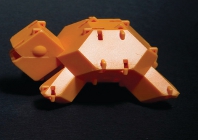For Seattle-based Jonathan Stapleton one particular college art class project became an obsession that led to a unique business opportunity and several patents.

Reptangles – turtles that snap. These colourful toys can snap and slide together in over 100 different ways
“We were working in wood, which meant we were creating models in three dimensions,” he remembers. The project would prove the catalyst for an interest in 3D tessellation and the end product – his own line of snaptogether toys, branded Reptangles.
Each plastic block has 56 connectors, allowing any two blocks to be attached to one another in hundreds of different ways. A set of 24 blocks can be used to create a dizzying variety of designs.
Building blocks
Produced in injection-moulded plastic and packaged in sets, the toys are bright building blocks for six year olds to help show the possibilities of exotic 3D shapes.
However, getting from the initial wooden mock-ups to today’s classroom-friendly production version wasn’t a simple equation. “I chose a truncated octahedron for the shape of the turtle shell,” says Stapleton. “Then, I took an extra turtle shell, cut it up, and made legs from the parts.
“I soon discovered that when I lined up matching angles on the legs and the shell, I was aligning the entire turtle with a 3D grid. The figure was guaranteed to fit together and line up.” But that was the easy part. “Then I had to make them stay together. Finally, I needed to find a way to produce these complex parts cost-effectively,” he adds.
The process involved developing sketches, CAD models, and models in wood, before the first turtle was eventually moulded from a plastic resin. The connectors, in particular, turned out to be a significant challenge. “Shapes like standard LEGO blocks are relatively straight forward,” says Stapleton.
“Blocks that stack vertically can be held together with a simple friction fit, and because they connect top to bottom they can be made in a simple two-part mould. With Reptangles, however, the blocks have mating faces on the top, the bottom, and the sides, and even those aren’t at simple right angles.”
Turtle power
What Stapleton didn’t fully appreciate at the design stage was that manufacturing the parts would prove to be an even greater challenge.
To keep costs low, he knew he would have to design a product that could be made in a two-part, straight-pull mould, which meant there could be no features of the design—faces or connectors—that would be trapped as the mould opened.
“Any standard connector, male or female, that isn’t located on a top or bottom of a surface could represent an undercut,” says Stapleton. “If you imagine a pyramid, for example, with connectors on each face, you can see how a post rising from any one of the sides would be trapped by a mould-half that was opening and closing vertically to form all four sides of the pyramid at once.”
The challenge was to develop a connector that could be produced in mould-halves opening in one direction but connecting in one or more other directions.
“I tried a friction fit,” he says, “but because of the complexity of the constructions and the resulting stresses on the connectors, the friction fit required unrealistically tight tolerances and restricted us to using resins that we didn’t want to use.
“The connectors had to snap together positively, but also release when pulled-apart.”
Right method
In May 2004 it was time to begin prototyping the design “I needed to be sure that they could be effectively made in straight-pull moulds. I probably could have used other prototyping methods, but actual injection moulding was the only method that would confirm the ‘mould-ability’ of the parts, and that was critical.”
Using prototyping service Protomold the first set of parts was delivered and testing showed the need for minor modifications easily fixed by modifying the original mould rather than making a new one.
With his design verified the marketing phase of the project began, he licensed the product to a larger company, and importantly, patented his turtles using the description ‘Multifaceted Nesting Modules’ and the connectors themselves.
When development of Reptangles was complete, Stapleton moved on to his next project: a design for isosceles tetrahedral blocks. Unlike the turtles, these are simple, four-sided (triangular pyramid) blocks. But, like Reptangles they can be combined to create a virtually unlimited array of forms.
Much of the thought and development that had gone into the first project was applied to the new idea. Unlike Reptangles, the yet-tobe-named tetrahedral blocks are single, rather than two-piece parts. As with the Reptangle halves, however, they had to be suitable for straight-pull moulds.
This latest project also led to a new patent application, for a method of designing a cored-out polyhedron, a solid, geometric figure that has many faces.
In 2007 Stapleton turned again to Protomold for prototypes. Currently he hasn’t decided whether to market or license his new creation, but through careful prototyping he does know that his latest creation works as he anticipated it to.
Problem solver
The prototyping process also offered other helpful pointers with Protomold’s experience helping solve some problems with the moulding process, which also had its own benefits.
“The nice thing about rapid injection moulding,” he adds, “is that you can’t make anything that wouldn’t work when it eventually goes into production. “If you need to increase dimension of any feature on the part you can ‘tweak’ the mould.
I achieved realistic dimensional accuracy with the same resin that would be used for production; I got to see if it was going to warp, and I could see if the angles came out right.”
From college art project to school classrooms, these educational toys are now a mathematical marvel.
Tessellated turtles prove to be a mathematical marvel
Default






